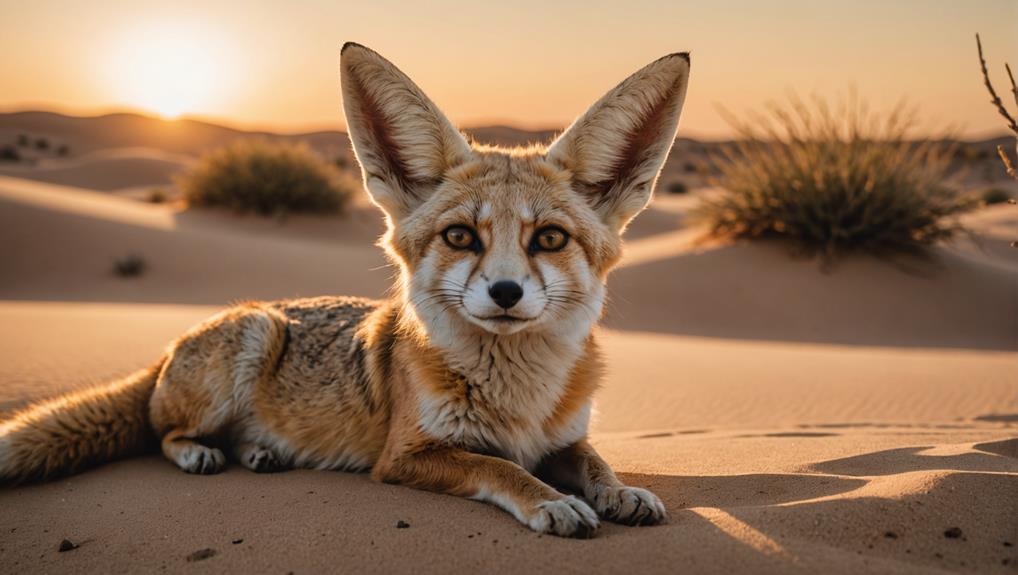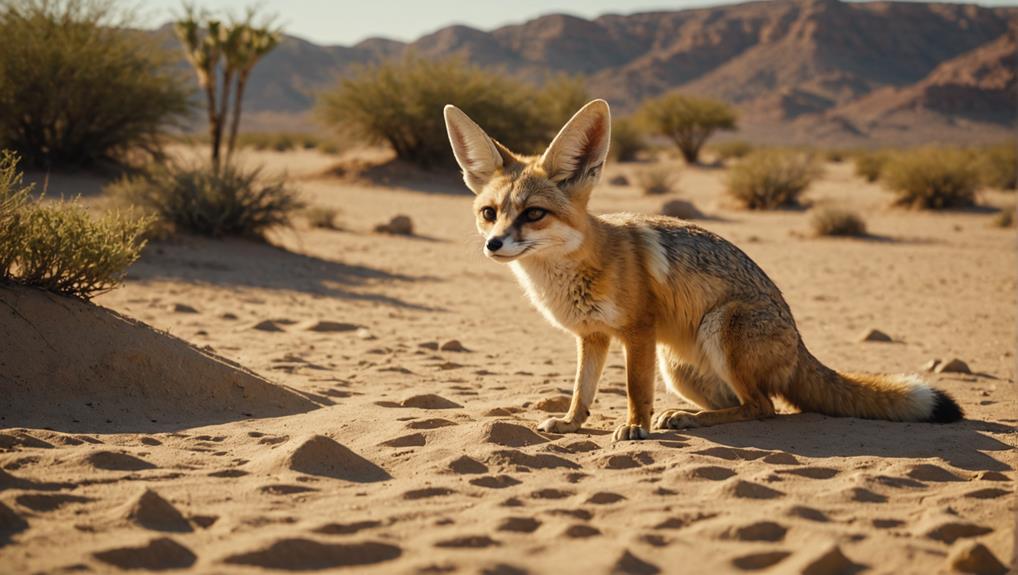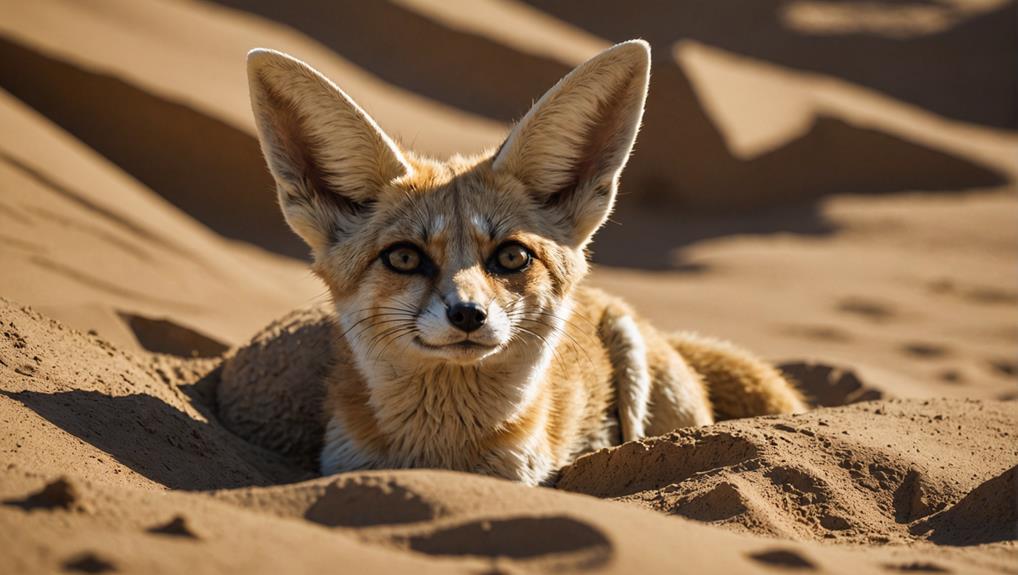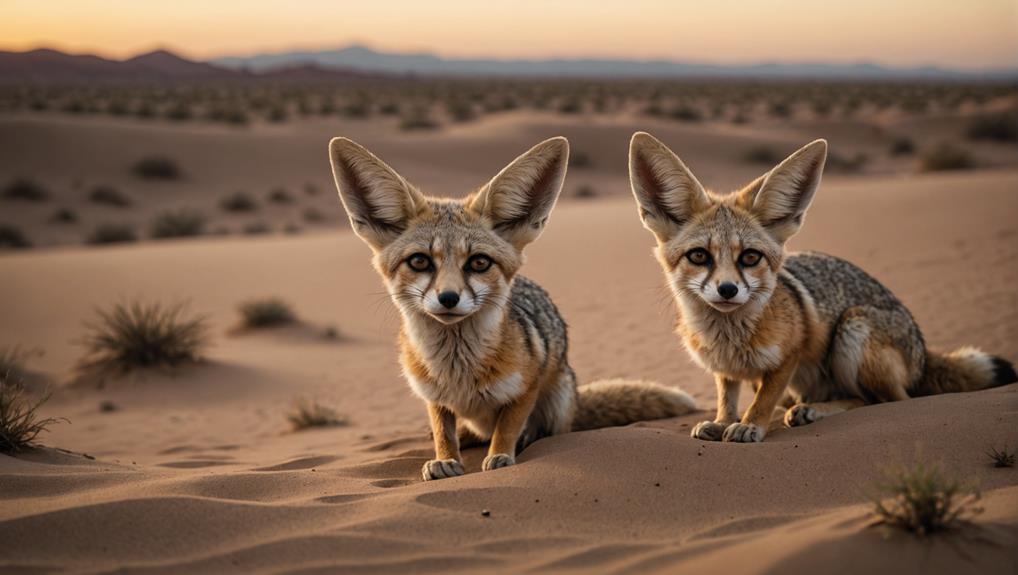The fennec fox loves the sandy landscapes of the Sahara Desert, thriving in warm, arid conditions. It digs deep burrows to escape the scorching heat and predators, making cozy homes that can go up to 3 meters underground. These cuties are nocturnal, being active at night to avoid the intense sun and to snack on insects or small rodents. Their big ears help cool them down while also giving them great hearing. Tucked away in peaceful burrows, they enjoy social time with family. If you're curious about how these playful foxes adapt to their environment, there's much more to uncover!
Contents
- 1 Desert Ecosystems and the Fennec Fox
- 2 Adapting to Arid Regions
- 3 Nocturnal Activities for Cooler Climates
- 4 Burrowing: A Fennec Fox's Refuge
- 5 Temperature Regulation Techniques
- 6 Dietary Adaptability in Sparse Habitats
- 7 Locating Water in Dry Environments
- 8 Social Habits in Fennec Fox Communities
- 9 Coping Mechanisms for Predators and Threats
- 10 Preserving the Fennec Fox: Conservation Efforts
- 11 Final Thoughts
Desert Ecosystems and the Fennec Fox
The fennec fox, a remarkable creature of the Sahara Desert, thrives in some of the harshest environments on Earth. This little fox has found its perfect habitat in the sandy, arid landscape of stabilized sand dunes. Here, you'll find vegetation that provides essential cover for hunting and resting. Can you imagine living where it rains only about four inches a year? That's just another day in the life of a fennec fox!
These clever critters prefer sandy soils, which make burrowing a breeze. They dig to create dens, escaping the intense daytime heat and finding refuge from predators. Their diet is as varied as their habitat, consisting of small rodents, reptiles, and some plant matter. In this desert ecosystem, the fennec fox collaborates with family members to hunt and stay safe.
It's heartwarming to see how these foxes form small groups, working together to thrive in such a tough environment.
Adapting to Arid Regions
When you think about fennec foxes, picture those little cuties scurrying around under the night sky of the Sahara.
They've got a knack for being nocturnal, which means they come alive when the sun goes down, making hunting and staying cool a whole lot easier.
Plus, their burrowing skills? Let's just say they're the underground champions, building cozy dens that keep them safe and comfy in their sandy homes!
Nocturnal Activity Patterns
In the desert's relentless heat, fennec foxes thrive by embracing a nocturnal lifestyle that allows them to dodge the sweltering sun. These adorable little creatures are experts at navigating their habitat after the sun sets, using their massive ears to hear every sound in the night.
By staying active during the cooler hours, they can hunt for prey like small rodents and insects while conserving energy and avoiding the extreme daytime temperatures.
- They rest underground in dens, escaping the heat.
- Their keen sense of smell helps them find food.
- They face the harsh conditions of the desert with grace.
- Watching them at night feels like witnessing a secret show!
The fennec fox's survival is a testament to nature's creativity. By being nocturnal, they effectively manage thermal stress and energy, making the most of their challenging environment.
Imagine how hard it must be to find dinner when the temperature's soaring! So, if you ever find yourself in the desert, remember the fennec fox, thriving under the stars while you're snoozing away in your cozy bed.
They're the true night owls of the arid world!
Burrowing and Tunneling Behavior
Fennec foxes dig intricate burrows that serve as vital shelters in their harsh desert environment. These clever little creatures use their strong, fur-covered paws to create cozy homes underground, protecting them from the extreme heat and pesky predators.
You'll find their burrows nestled in stabilized sand dunes, which aren't just nice for shelter; they're also perfect hunting grounds for small rodents and insects.
When you think about it, these foxes really know how to adapt! Their burrows can extend several feet deep, often featuring multiple entrances for easy access and escape. This design helps with thermoregulation, keeping them cool during the day and warm at night.
Plus, Fennec foxes are social animals, so they often engage in communal burrowing. Imagine a cozy den filled with family, sharing warmth and stories—how heartwarming is that?
Nocturnal Activities for Cooler Climates

The desert comes alive at night, as fennec foxes venture out to explore their surroundings. These adorable little creatures thrive in the cooler temperatures, making the most of their nocturnal lifestyle.
While you're cozying up for the night, these furry friends are busy socializing and foraging for food. They've got this whole night-time routine down to a science!
- Imagine the thrill of watching them dart across the sandy deserts, their large ears perked up.
- Think about how they skillfully avoid the blazing heat, effortlessly conserving energy.
- Picture them playing with one another, their curiosity leading to delightful discoveries.
- Feel the joy of knowing they're safe in their burrows during the day, resting up for their next adventure.
Burrowing: A Fennec Fox's Refuge
Burrowing serves as a vital refuge for fennec foxes, enabling them to thrive in the harsh desert environment.
These clever creatures dig intricate and complex burrows, using their strong front paws to create a cozy underground shelter. Imagine how great it must feel to escape the blistering heat and fierce winds! These burrows can reach depths of up to 3 meters, providing a perfect home for nesting and raising their young.
But burrowing isn't just about having a nice place to sleep.
It also plays a key role in thermoregulation, keeping fennec foxes cool during the scorching day and warm when the desert nights turn chilly. Plus, they're savvy little food hoarders!
Temperature Regulation Techniques

Adapting to extreme desert temperatures, fennec foxes employ several remarkable techniques to regulate their body heat. With large ears measuring 4 to 6 inches long, they not only hear their prey but also radiate body heat, keeping themselves cool. Their sandy fur serves a dual purpose—blending into the desert landscape while reflecting sunlight, which helps in temperature regulation.
When the sun blazes overhead, these clever creatures become nocturnal, avoiding the sweltering heat of the day. Instead, they cozy up in their underground dens, resting and staying cool.
Here are some fascinating aspects of their temperature regulation:
- Their thick fur provides insulation against chilly nights and extreme heat.
- The soft, sandy fur helps reflect sunlight, reducing heat absorption.
- Their padded feet act as a barrier against the hot sand, letting them roam freely without burning those adorable paws.
- By being active at night, they dodge the oppressive daytime temperatures.
Dietary Adaptability in Sparse Habitats
Thriving in the harsh conditions of the desert, fennec foxes showcase remarkable dietary adaptability that enables them to survive in sparse habitats.
These clever little omnivorous scavengers have a varied diet that includes small rodents, reptiles, insects, birds, fruits, and even eggs. When food becomes scarce, they use their digging skills to unearth hidden prey, showing just how resourceful they can be in nutrient-scarce environments.
One fascinating aspect of fennec fox life is their knack for cooperative foraging. They often work together in small family groups, making food searches more effective and transforming meal time into a fun, social event.
And speaking of meals, these foxes are great at water conservation; they can go for long stretches without drinking, getting the moisture they need from their food instead.
They even take it a step further by caching their food—burying it for those rainy (or rather, dry) days.
Locating Water in Dry Environments

While it may seem impossible to find water in the vast expanse of the desert, fennec foxes have evolved remarkable strategies to locate moisture in their dry environments.
These clever little creatures primarily get their hydration from the food they eat, showing just how adaptable they're to arid conditions. Their diet consists of small rodents, insects, and fruits, all packed with moisture.
Here are some incredible adaptations fennec foxes use to thrive:
- They forage at night, avoiding the harsh daytime heat.
- Their thick fur and large ears help regulate their body temperature, reducing water needs.
- They cleverly sip moisture from dew that forms on plants.
- They can go long stretches without free-standing water, relying on nature's bounty.
Imagine those resourceful fennec foxes, darting around under the moonlight, foraging and surviving where others might falter.
Their unique foraging behaviors and adaptations not only help them find water but also inspire us to appreciate the resilience of nature.
Social Habits in Fennec Fox Communities
Fennec foxes not only excel at surviving in harsh environments but also exhibit fascinating social habits within their communities. These clever creatures live in small family groups, usually up to ten individuals, which makes their social interactions vibrant and engaging.
You might find them playfully romping around, especially siblings who show off their strong bonds and cooperative behaviors. Communication is key for Fennec foxes, and they use a variety of vocalizations to keep the family unit connected. Imagine the chatter and chirps that echo through the desert!
Males also participate in territorial marking, using urine to claim their space and establish dominance, especially during mating season. It's like their very own version of a "keep out" sign!
When the sun sets, these adorable foxes demonstrate their love for communal resting. Cuddling up together not only keeps them warm but also nurtures their social lives. In a way, they remind us of how important it's to have a close-knit community.
Whether they're playing or resting, Fennec foxes truly embody the spirit of teamwork and companionship.
Coping Mechanisms for Predators and Threats

Survival in the harsh desert environment demands clever coping mechanisms to evade predators and threats. The fennec fox showcases remarkable strategies to navigate its extreme habitat. One of its primary tactics is burrowing behavior, creating underground dens that provide safe havens from both predators and the unforgiving heat.
Here are some of the amazing adaptations that help the fennec fox thrive:
- Camouflage: Its sandy, cream-colored fur blends seamlessly into the desert landscape.
- Large ears: Not only do they help with heat dissipation, but they also enhance its hearing to catch sounds of lurking dangers.
- Nocturnal lifestyle: By being active at night, the fennec fox avoids encounters with daytime predators while enjoying cooler temperatures.
- Agility and alertness: Quick reflexes and sharp senses help it dart away from threats in a flash.
These coping mechanisms reflect the fennec fox's incredible resilience. They remind us of the importance of adapting to our surroundings.
Just as this adorable creature finds ways to survive, we can learn to embrace our challenges with a bit of creativity and agility!
Preserving the Fennec Fox: Conservation Efforts
Conservation is vital for the fennec fox, as its existence hangs in the balance due to habitat loss and human activities. You mightn't realize it, but desertification and encroachment are pushing these adorable critters into a corner.
That's where conservation efforts come in, focusing on protecting stabilizing sand dunes and areas rich in vegetation. These habitats are essential for their survival and reproduction.
Monitoring fennec fox populations is tricky, but innovative methods like camera traps are helping us get a clearer picture. While the fennec fox is currently classified as Least Concern, the rising popularity of the pet trade raises some eyebrows.
We need to address sustainability concerns to keep their populations healthy. Collaboration with local communities is key.
By working together, we can reduce hunting pressures and promote awareness of the fennec fox's ecological importance. After all, these little foxes play a big role in their environment.
Final Thoughts
In the grand scheme of desert life, the fennec fox stands out as a true survivor. With its clever adaptations, like burrowing and nocturnal habits, it's a master at thriving in harsh conditions. By understanding these amazing creatures and their habitat needs, we can help protect them for future generations. So, let's appreciate the fennec fox and do our part in keeping their desert home safe. After all, who wouldn't want to befriend such a cute little critter?














